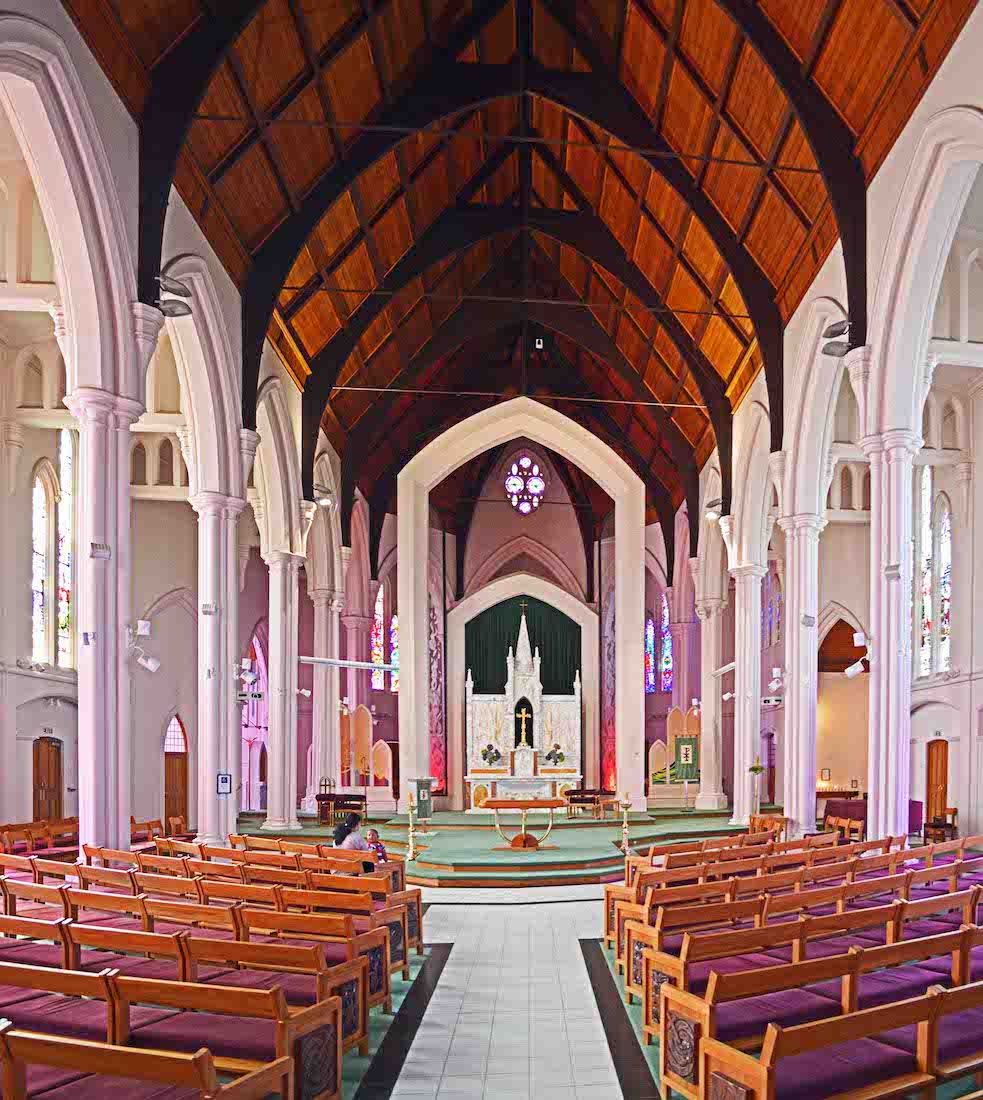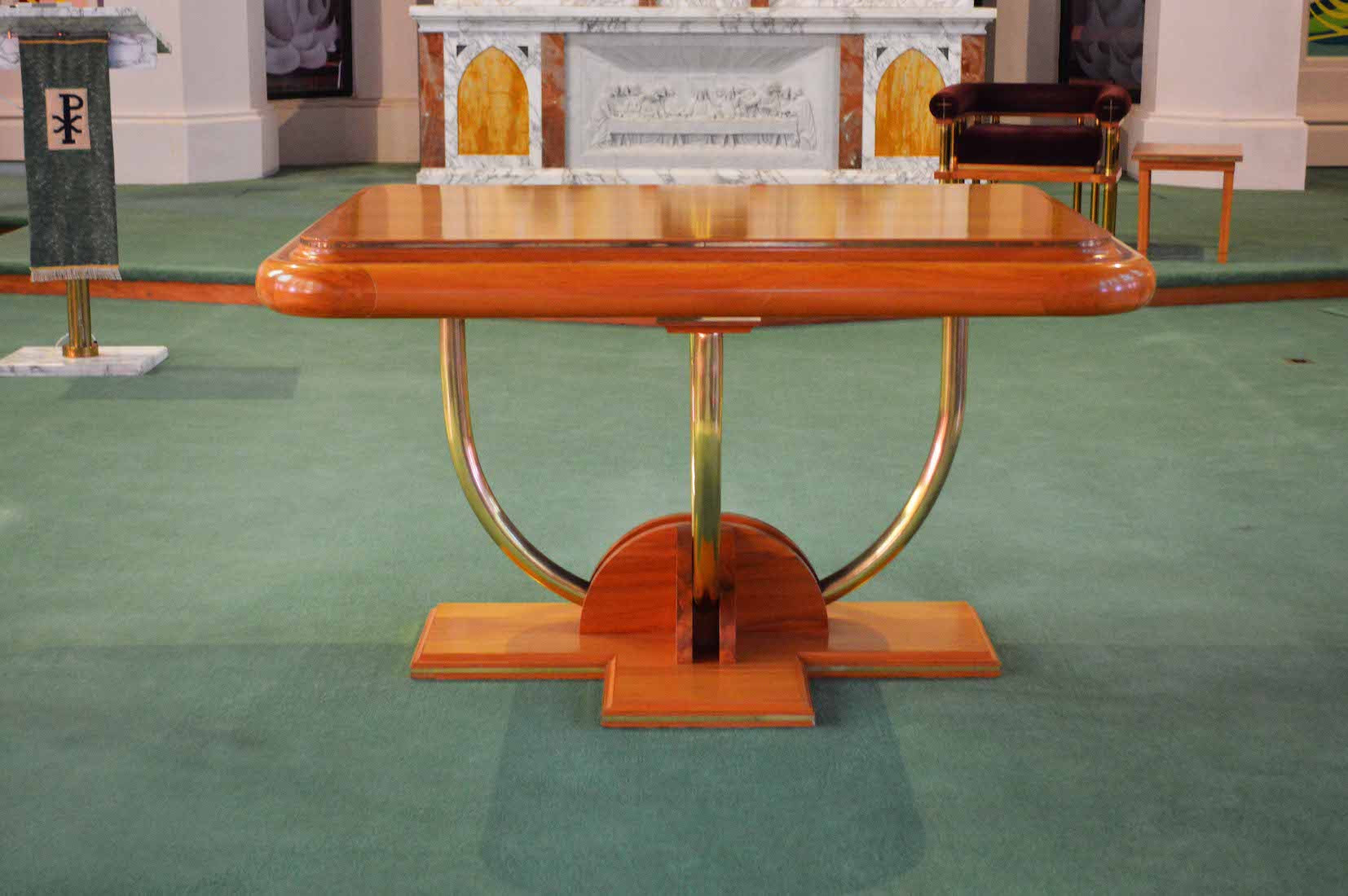
The narthex is the more formal area opening at right through to the nave. Against the far wall is a statue of The Sacred Heart. PLAN
22. NARTHEX, LOOKING NORTH

Here is the narthex in the other direction. We notice the main Cathedral doors opening out at the left. Opposite the nave entry is a large crucifix, and beyond a couple of plaques, and in the distance a statue of St Patrick, and, in fact, a small crucifix.
23. IN THE NARTHEX
The large crucifix was in the previous St Patrick’s Church in Broad Street. Above the dedication plaque is a Maori carving representing Christ and the Vicar of Christ – Peter the Fisherman – bringing Christ as a life-giving, all-embracing net cast to bring others to Him.
24. ST PATRICK AND CRUCIFIX
At the entry to the narthex we are greeted by St Patrick, depicted with a snake underfoot (the legend is that he rid Ireland of snakes). The small crucifix hangs by a brass plate commemorating the 2001 opening of this complex.
26. NAVE ROOF
The nave roof is a simple timber-lined gable. Simplicity is a feature of this Cathedral.
27. NORTH NAVE
The North side of the nave is an aisle with internal buttresses. One’s eye is drawn to the large triplet stained glass windows, while a pink glow emanates from the smaller lower panes. The large windows are from the studios of F. X. Zettler, Munich.
28. NORTH NAVE WINDOWS
Each of the nave windows depicts a Parable of our Lord. Here from the left we have: The Prodigal Son, The Rich Man and Lazaras, The Pharisee and the Publican, The Rich Young Man, and The Parable of the Talents.
29. NAVE: WEST VIEW
As we move across the sanctuary to the South side, we notice the view of the nave to the West, with the grand pipe organ placed high above the balcony. Notice too below, the large crucifix, and the blue doors.
30. SOUTH NAVE
In lay-out, the South nave is the reflection of the North nave. We note the placing of the baptismal font at left – different from the position shown in the older Plan.
31. SOUTH NAVE WINDOWS
These windows continue the Parable theme of the North windows. From left we have: The Vineyard, The Sower, The Good Samaritan, The Barren Tree, and The Good Shepherd.
32. PIPE ORGAN
The present organ was built at the beginning of the century by English organ builder Arthur Holiday, and installed here in 1978 by Crofts, who modified the specifications and added extra ranks of pipes. The organ was completely rebuilt and expanded in 1991 by organ builder George Deans.
33. PEWS
The pews were designed from the original pews in an ergonomic design. They are arranged on either side of the altar to bring the people closer to the central focus of the Mass with the priest at the altar. Each pew features a Maori carving at the aisle end. [1]
34. MAORI CARVINGS
Each Maori carving has a spiritual meaning. From left: • The development of Christ within and from one generation to another. • The heart of love in the midst of the wilderness. • Our activity, centred on Christ’s word, spirals out to fill the whole world. [1]
36. ALTAR
The altar is carefully crafted out of heart rimu, a native tree of New Zealand. It takes central place as the table of the Eucharist. It is simple in design and unobtrusive in form.
37. CATHEDRA AND LECTERN
The cathedra is the seat of the Bishop, from which the Cathedral takes its name. Like the altar, it is simple in design, and has on each side a significant Maori carving. These illustrate Moses (the Law) and Solomon (Wisdom). The Lectern, and the similar Ambo, are made from marble from the old altar rails. [6, 7]
38. SANCTUARY FOCUS
Although the simple modern altar is supposed to be the focus of worship, there is little doubt that the actual focus is on the stunning High Altar with its silhouetted central cross, and flanked by the Pentecost flames.
39. McMANUS MEMORIAL ALTAR
The marble High Altar is dedicated to Monsignor James McManus, the seventh Parish Priest. It was installed in 1963. In 1988 it was moved forward to its present position. [10]
40. LAST SUPPER
On the front marble panel of the High Altar is a fine carving of the Last Supper. There must be countless reproductions of Leonardo da Vinci’s initial masterpiece.


















